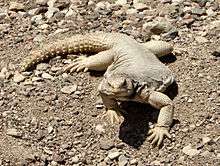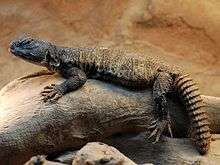Uromastyx
Uromastyx is a genus of African and Asian agamid lizards, the member species of which are commonly called spiny-tailed lizards, uromastyces, mastigures, or dabb lizards. Lizards in the genus Uromastyx are primarily herbivorous, but occasionally eat insects and other small animals, especially young lizards. They spend most of their waking hours basking in the sun, hiding in underground chambers at daytime or when danger appears. They tend to establish themselves in hilly, rocky areas with good shelter and accessible vegetation.
| Uromastyx[1] | |
|---|---|
 | |
| Egyptian spiny-tailed lizard (Uromastyx aegyptia) | |
| Scientific classification | |
| Kingdom: | Animalia |
| Phylum: | Chordata |
| Class: | Reptilia |
| Order: | Squamata |
| Suborder: | Iguania |
| Family: | Agamidae |
| Subfamily: | Uromasticinae |
| Genus: | Uromastyx Merrem, 1820 |
| Species | |
|
See text | |
Taxonomy
.jpg)
The generic name (Uromastyx) is derived from the Ancient Greek words ourá (οὐρά) meaning "tail" and -mastix (μάστιξ) meaning "whip" or "scourge", after the thick-spiked tail characteristic of all Uromastyx species.[2]
Species

The following species are in the genus Uromastyx.[3] Three additional species were formerly placed in this genus, but have been moved to their own genus, Saara.[3][4]
- Uromastyx acanthinura Bell, 1825 – Bell's dabb lizard
- Uromastyx aegyptia (Forskål, 1775) – Egyptian mastigure, Leptien's mastigure
- Uromastyx alfredschmidti Wilms & Böhme, 2001 – Schmidt's mastigure
- Uromastyx benti (Anderson, 1894) – Bent's mastigure
- Uromastyx dispar Heyden, 1827 – Sudan mastigure
- Uromastyx (dispar) flavifasciata Mertens, 1962
- Uromastyx (dispar) maliensis Joger & Lambert, 1996 – Mali uromastyx
- Uromastyx geyri (L. Müller, 1922) – Saharan spiny-tailed lizard
- Uromastyx macfadyeni Parker, 1932 – Macfadyen's mastigure[5]
- Uromastyx nigriventris Rothschild & Hartert, 1912
- Uromastyx occidentalis Mateo, Geniez, Lopez-Jurado & Bons, 1999 – giant spiny-tailed lizard
- Uromastyx ocellata Lichtenstein, 1823 – eyed dabb lizard
- Uromastyx ornata Heyden, 1827 – ornate mastigure
- Uromastyx princeps O’Shaughnessy, 1880 – princely mastigure
- Uromastyx thomasi Parker, 1930 – Oman spiny-tailed lizard
- Uromastyx yemenensis Wilms & Schmitz, 2007 – Yemen spiny-tailed lizard
Description
Their size ranges from 25 cm (10 in) (U. macfadyeni) to 91 cm (36 in) or more (U. aegyptia). Hatchlings or neonates are usually no more than 7–10 cm (3–4 in) in length. Like many reptiles, these lizards' colors change according to the temperature; during cool weather they appear dull and dark but the colors become lighter in warm weather, especially when basking; the darker pigmentation allows their skin to absorb sunlight more effectively.
Their spiked tail is muscular and heavy, and can be swung at an attacker with great velocity, usually accompanied by hissing and an open-mouthed display of (small) teeth.[6] Uromastyxes generally sleep in their burrows with their tails closest to the opening, in order to thwart intruders.[6]
Distribution
Uromastyx inhabit a range stretching through most of North and Northeast Africa, the Middle East, ranging as far east as Iran. Species found further east are now placed in the genus Saara.[4] Uromastyx occur at elevations from sea level to well over 900 m (3,000 ft). They are regularly eaten, and sold in produce markets, by local peoples. Uromastyx tend to bask in areas with surface temperatures of over 50 °C (120 °F).
Ecology
Reproduction
A female Uromastyx can lay anywhere from 5 to 40 eggs, depending on age and species. Eggs are laid approximately 30 days following copulation with an incubation time of 70–80 days.[7] The neonates weigh 4–6 g (0.14–0.21 oz) and are about 5 cm (2 in) snout to vent length.[7] They rapidly gain weight during the first few weeks following hatching.[7]
A field study in Algeria concluded that Moroccan spiny-tailed lizards add approximately 5 cm (2 in) of total growth each year until around the age of 8–9 years.[7]
Wild female uromastyx are smaller and less colorful than males. For example, U. (dispar) maliensis females are often light tan with black dorsal spots, while males are mostly bright yellow with mottled black markings. Females also tend to have shorter claws. In captivity female U. (dispar) maliensis tend to mimic males in color.[8] Maliensis are, therefore, reputably difficult to breed in captivity.
Diet
These lizards acquire most of the water they need from the vegetation they ingest. In the wild they generally eat any surrounding vegetation. When hatching, baby uromastyx eat their own mother's feces as their first meal before heading off to find a more sustainable food source.
Captive uromastyxs' diets should be largely herbivorous, consisting primarily of endive, dandelion greens, bok choy, escarole, and most ground growing vegetables with little to no sugar, or of course an appropriate type of store-bought vegetarian lizard food. Some lettuces have almost no nutritive value. The lighter, whiter lettuce is not as nutritionally effective as the darker green lettuce. It is very important to avoid spinach, chard and flowering kale in the diets of all reptiles, since the oxalates in spinach prevent the uptake of calcium into the bloodstream. However, a special UVB bulb must be used in order for them to absorb the calcium from the gut. They can consume de-thorned cacti with their powerful jaws, especially if they need water. The lizards' food can be dusted with a calcium and a uromastyx designed supplement to help prevent health problems. While young uromastyx, like young iguanas, do eat some insects in order to gain access to the added nutrients while they are rapidly growing, the high levels of protein may cause liver damage in adults. These animals are primarily herbivores, as stated above, and so it is generally felt that they should only be fed plant matter. In the wild, adult Malis have been reported to eat insects at certain times of the year, when it is hot and their only food source available would be insects.
Consumption by humans
Uromastyx maliensis, known as "ḍabb" (Arabic: ضَـبْ) by peninsular Arabs, is consumed as food by the population of the Arabian peninsula, mainly those residing in the interior regions of Saudi Arabia.[9][10][11][12] This lizard is considered an "arabian delicacy".[13] It is recorded that when an Uromastyx was brought to the Prophet Muhammad by Bedouins, the Prophet did not eat the lizard but Muslims were not prohibited by him from consuming it, thus the Prophet's companion Khalid bin Walid consumed the lizard.[14][15][16][17]
Captivity
Historically, captive Uromastyx had a poor survival rate, due to a lack of understanding of their dietary and environmental needs. In recent years, knowledge has significantly increased, and appropriate diet and care has led to survival rates and longevity approaching and perhaps surpassing those in the wild.
The Mali Uromastyx (Uromastyx (dispar) maliensis) is considered an ideal species of Uromastyx to choose as a pet because they readily adapt to a captive environment. Another species that adapts to captivity well, and comes in "red" and "yellow", is Uromastyx geyri, commonly called the Saharan Uromastyx. The red version is marketed as a red Niger Uromastyx but the yellow version is marketed as a yellow Niger Uromastyx. Artificial UVB/UVA light and vitamin supplements must be balanced with proper food and nutrition, UVB light is required for calcium absorption from the gut. Most commercially available UVB lights lose efficiency after 6 months and need to be replaced. Proper enclosures can be costly, as these are roaming animals with large space needs for their size, combined with the need to provide heat and ultraviolet light. Though the lizards bask at very high temperatures, there must be a temperature gradient within the enclosure allowing them to cool off away from the heat lamps. A cooling-down period over winter months can trigger the breeding response when temperatures rise in the spring. The temporary slowing-down of their metabolisms also lengthens the animals' lifespans.
Uromastyx are removed from the wild in an unregulated manner for the pet and medicinal trade in Morocco, despite their protected status in the country. Conditions of the animals while being sold is often extremely poor and overcrowding is common.[18]
Uromastyx are burrowing lizards, and need substrate deep enough to burrow in, or a low structure under which to hide. In the wild, these lizards' burrows can reach 3 m (10 ft) in length.
See also
References
- "Uromastyx ". Integrated Taxonomic Information System.
- "Oxford English Dictionary, uroˈmastix, n." Oxford English Dictionary. Retrieved 16 June 2016.
- Genus Uromastyx at The Reptile Database. www.reptile-database.org.
- Wilms TM, Böhme W, Wagner P, Lutzmann N, Schmitz A (2009). "On the Phylogeny and Taxonomy of the Genus Uromastyx Merrem, 1820 (Reptilia: Squamata: Agamidae: Uromastycinae) – Resurrection of the Genus Saara Gray, 1845". Bonner zoologische Beiträge 56 (1/2): 55–99.
- Beolens, Bo; Watkins, Michael; Grayson, Michael (2011). The Eponym Dictionary of Reptiles. Baltimore: Johns Hopkins University Press. xiii + 296 pp. ISBN 978-1-4214-0135-5. (Uromastyx macfdyeni, p. 164).
- Capula, Massimo; Behler, John L. (1989). Simon & Schuster's Guide to Reptiles and Amphibians of the World. New York: Simon & Schuster. p. 259. ISBN 0-671-69098-1.
- Vernet, Roland; Lemire, Michel; Grenot, Claude J.; Francaz, Jean-Marc (1988). "Ecophysiological comparisons between two large Saharan Lizards, Uromastyx acanthinurus (Agamidae) and Varanus griseus (Varanidae)". Journal of Arid Environments 14:187–200.
- "Deer Fern Farms Mali Uromastyx Page". Deerfernfarms.com. 2009-01-13. Archived from the original on 2009-08-27. Retrieved 2016-01-07.
- "Hunting 'dabb' in Al-Asyah". Arab News. 2001-04-27. Retrieved 2016-01-07.
- "Saudi Aramco World: The Toad-Head from Najd And Other Reptiles". Archive.aramcoworld.com. Retrieved 2016-01-07.
- American Bedu (September 26, 2008). "Don't Know What to Cook? How About Dhub – Traditional Saudi Beudion Dish". American Bedu.
- Usman, Omar (July 10, 2008). "Sunnah of the Dhab Lizard Delicacy". Muslim Matters.
- John P. Rafferty (January 2011). Deserts and Steppes. The Rosen Publishing Group. pp. 55–. ISBN 978-1-61530-317-5.
- "SahihMuslim.Com". SahihMuslim.Com. Retrieved 2016-01-07.
- IslamKotob (1978). Sahih Muslim: Being Traditions of the Sayings and Doings of the Prophet Muhammad as Narrated by His Companions and Compiled Under the Title Al-Jami'-us-sahih : with Explanatory Notes and Brief Biographical Sketches of Major Narrators. Islamic Books. pp. 1242–. GGKEY:A3373925T9E.
- "Quran / Hadith English Translation - Search Engine". Religeo.com. Archived from the original on 2015-12-24. Retrieved 2016-01-07.
- "Ruling on Different Types of Lizards". ImamFaisal.com. 2011-10-27. Retrieved 2016-01-07.
- Daniel Bergin (2014-11-04). "Open, Unregulated Trade in Wildlife in Morocco's Markets (PDF Download Available)". Researchgate.net. Retrieved 2016-01-07.
External links
| Wikimedia Commons has media related to Uromastyx. |
| Wikispecies has information related to Uromastyx |